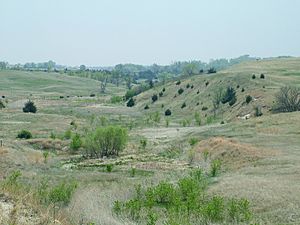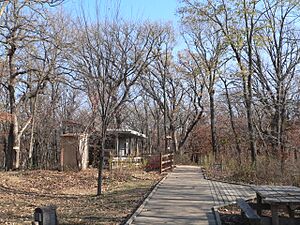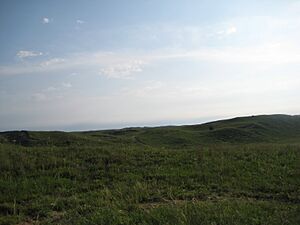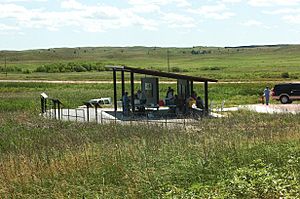List of National Natural Landmarks in Nebraska facts for kids
A National Natural Landmark (NNL) is a special place in the United States that shows off the best examples of America's natural history. These places are chosen because they have amazing landforms, rocks, fossils, plants, or animals. They help us learn about Earth's past and how nature works.
Nebraska is a state in the central United States, and it has 5 of these incredible National Natural Landmarks. These sites protect unique natural features, from ancient fossil beds to vast sand dunes. Let's explore them!
Contents
What is a National Natural Landmark?
A National Natural Landmark is like a natural treasure chest! It's a place recognized by the U.S. government for its outstanding natural features. These features might be rare plants, unique animals, special rock formations, or important fossil sites. The goal is to protect these places so everyone can learn from them and enjoy them for many years.
Nebraska's Natural Wonders
Nebraska is home to five amazing National Natural Landmarks. Each one tells a different story about the state's natural history and beauty.
Ashfall Fossil Beds
The Ashfall Fossil Beds were named a National Natural Landmark in 2006. This incredible site is near Orchard. It's famous for having hundreds of complete skeletons of ancient animals. These animals were buried very quickly by a thick layer of volcanic ash about 12 million years ago!
Imagine a watering hole where many animals came to drink. Then, a huge volcano erupted far away, covering everything in ash. This ash preserved the animals so well that scientists can still see their bones almost perfectly. It's like a natural time capsule! This type of fossil site is called a lagerstätte, which means a place with exceptionally well-preserved fossils.
Dissected Loess Plains
The Dissected Loess Plains became a National Natural Landmark in 1987. You can find this area in Lincoln County. This landmark shows off deep canyons and valleys that have been carved out by erosion. These features are found in layers of loess, which is a type of fine, wind-blown silt.
The loess deposits here are more than 200 feet (about 60 meters) thick! Over thousands of years, wind and water have slowly worn away the soft loess, creating the dramatic landscape you see today. It's a great example of how natural forces can shape the land.
Fontenelle Forest
Fontenelle Forest was recognized as a National Natural Landmark in 1964. It is located in Sarpy County. This forest is very special because it's the largest virgin forest in Nebraska. A virgin forest means it's an old-growth forest that has not been significantly disturbed by humans.
This beautiful forest is a private area, but it's open for people to visit and enjoy nature. It's a peaceful place where you can see many different kinds of trees, plants, and animals, just as they have existed for a very long time.
Nebraska Sand Hills
The Nebraska Sand Hills were named a National Natural Landmark in 1984. This huge area is mostly in Grant County, but it stretches across a large part of the state. It's known for being the largest sand dunes complex in the entire Western Hemisphere!
Even though they are called "sand hills," many of these dunes are covered with grass. This grass helps to hold the sand in place. Beneath the sand, there's a huge underground water supply called the Ogallala Aquifer. This water feeds many lakes and wetlands in the Sand Hills, making it an important home for wildlife.
Valentine National Wildlife Refuge
The Valentine National Wildlife Refuge became a National Natural Landmark in 1976. It is located in Cherry County. This refuge protects a unique tallgrass prairie ecosystem that is special to the central Great Plains.
An ecosystem is a community of living things (plants and animals) and their environment. The Valentine National Wildlife Refuge is a mix of sandhills and wetlands, creating a perfect habitat for many birds, fish, and other animals. It's a federal property, meaning it's managed by the U.S. government to protect its natural beauty and wildlife.





